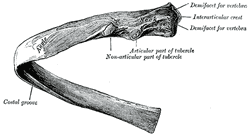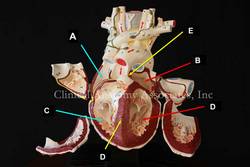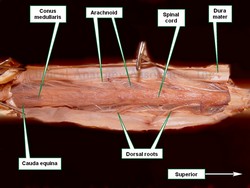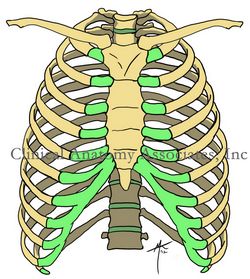
Medical Terminology Daily (MTD) is a blog sponsored by Clinical Anatomy Associates, Inc. as a service to the medical community. We post anatomical, medical or surgical terms, their meaning and usage, as well as biographical notes on anatomists, surgeons, and researchers through the ages. Be warned that some of the images used depict human anatomical specimens.
You are welcome to submit questions and suggestions using our "Contact Us" form. The information on this blog follows the terms on our "Privacy and Security Statement" and cannot be construed as medical guidance or instructions for treatment.
We have 522 guests online

Jean George Bachmann
(1877 – 1959)
French physician–physiologist whose experimental work in the early twentieth century provided the first clear functional description of a preferential interatrial conduction pathway. This structure, eponymically named “Bachmann’s bundle”, plays a central role in normal atrial activation and in the pathophysiology of interatrial block and atrial arrhythmias.
As a young man, Bachmann served as a merchant sailor, crossing the Atlantic multiple times. He emigrated to the United States in 1902 and earned his medical degree at the top of his class from Jefferson Medical College in Philadelphia in 1907. He stayed at this Medical College as a demonstrator and physiologist. In 1910, he joined Emory University in Atlanta. Between 1917 -1918 he served as a medical officer in the US Army. He retired from Emory in 1947 and continued his private medical practice until his death in 1959.
On the personal side, Bachmann was a man of many talents: a polyglot, he was fluent in German, French, Spanish and English. He was a chef in his own right and occasionally worked as a chef in international hotels. In fact, he paid his tuition at Jefferson Medical College, working both as a chef and as a language tutor.
The intrinsic cardiac conduction system was a major focus of cardiovascular research in the late nineteenth and early twentieth centuries. The atrioventricular (AV) node was discovered and described by Sunao Tawara and Karl Albert Aschoff in 1906, and the sinoatrial node by Arthur Keith and Martin Flack in 1907.
While the connections that distribute the electrical impulse from the AV node to the ventricles were known through the works of Wilhelm His Jr, in 1893 and Jan Evangelista Purkinje in 1839, the mechanism by which electrical impulses spread between the atria remained uncertain.
In 1916 Bachmann published a paper titled “The Inter-Auricular Time Interval” in the American Journal of Physiology. Bachmann measured activation times between the right and left atria and demonstrated that interruption of a distinct anterior interatrial muscular band resulted in delayed left atrial activation. He concluded that this band constituted the principal route for rapid interatrial conduction.
Subsequent anatomical and electrophysiological studies confirmed the importance of the structure described by Bachmann, which came to bear his name. Bachmann’s bundle is now recognized as a key determinant of atrial activation patterns, and its dysfunction is associated with interatrial block, atrial fibrillation, and abnormal P-wave morphology. His work remains foundational in both basic cardiac anatomy and clinical electrophysiology.
Sources and references
1. Bachmann G. “The inter-auricular time interval”. Am J Physiol. 1916;41:309–320.
2. Hurst JW. “Profiles in Cardiology: Jean George Bachmann (1877–1959)”. Clin Cardiol. 1987;10:185–187.
3. Lemery R, Guiraudon G, Veinot JP. “Anatomic description of Bachmann’s bundle and its relation to the atrial septum”. Am J Cardiol. 2003;91:148–152.
4. "Remembering the canonical discoverers of the core components of the mammalian cardiac conduction system: Keith and Flack, Aschoff and Tawara, His, and Purkinje" Icilio Cavero and Henry Holzgrefe Advances in Physiology Education 2022 46:4, 549-579.
5. Knol WG, de Vos CB, Crijns HJGM, et al. “The Bachmann bundle and interatrial conduction” Heart Rhythm. 2019;16:127–133.
6. “Iatrogenic biatrial flutter. The role of the Bachmann’s bundle” Constán E.; García F., Linde, A.. Complejo Hospitalario de Jaén, Jaén. Spain
7. Keith A, Flack M. The form and nature of the muscular connections between the primary divisions of the vertebrate heart. J Anat Physiol 41: 172–189, 1907.
"Clinical Anatomy Associates, Inc., and the contributors of "Medical Terminology Daily" wish to thank all individuals who donate their bodies and tissues for the advancement of education and research”.
Click here for more information
- Details
|
The root term [-chondr-] arises from the Greek [χόνδρος] or [chondros] meaning "cartilage" or "gristle". The Latin equivalent is [cartilago] giving us the synonymous root term [-cartilag-]. This root term is used in medical words such as:
|
|
| Back to MTD Main Page | Subscribe to MTD |
- Details

Thoracic rib, Posteroinferior view
The ribs form the lateral bony wall of the thorax. The ribs are paired and there are 12 pairs of ribs in the human thorax, most of them connecting the thoracic spine with the sternum. They are numbered from superior to inferior.
Ribs have different anatomical characteristics depending on their level. A typical rib has the following characteristics from posterior to anterior:
• Head: The head of each rib articulates with one or two ribs depending on their level. Typically ribs number 1,2, 10, 11, and 12 articulate with one vertebra, while the rest articulate with two vertebrae.
• Facets: These are the articular surfaces found in the head of each rib. They are covered by hyaline cartilage and form part of the costovertebral synovial joints. In the case of ribs 3 to 9, since they articulate with two vertebrae, they have two facets, each one called a demifacet, with an interarticular crest between them.
• Neck: A short, somewhat narrower portion of the rib that projects straight posterolaterally.
• Costal tubercle: A bony protuberance, usually with two components, one articular and one non-articular. The articular part of the costal tubercle presents with a facet that articulates with the transverse process of a thoracic vertebra.
• Costal angle: A sharp posterior curvature of the rib. The body when supine rests of these costal angles which deflect pressure from the thoracic spine.
• Costal body: The area of the rib anterior to the costal angle. In most ribs this oval-shaped region of the rib presents with an inferior and internal groove. This is the costal groove or costal sulcus. The corresponding level intercostal artery, vein, and nerve are found in the costal sulcus.
• Costal cartilage: All ribs have an anterior fibrocartilaginous component. Some of them attach directly to the sternum (chondrosternal joints), while some of them attach only to other costal cartilages (chondrochondral joints).
The 12 pairs of ribs are divided as follows:
• True ribs: Ribs 1-7, which attach by way of their costal cartilage directly to the sternum
• False ribs: Ribs 8-10, whose costal cartilage attach only to the cartilage of the superior rib, creating a lower border for the thoracic cage known as the costal margin.
• Free or "floating" ribs: Ribs 11 and 12. Their anterior cartilaginous end does not attach to sternum or other cartilage, so the end is free. The term "floating" although used, is a misnomer as these ribs do attach posteriorly to the thoracic spine.
There can be anatomical variations to the ribs, including the existence of extra cervical or lumbar ribs.
Sources:
1 "Tratado de Anatomia Humana" Testut et Latarjet 8 Ed. 1931 Salvat Editores, Spain
2. "Anatomy of the Human Body" Henry Gray 1918. Philadelphia: Lea & Febiger
Original image courtesy of bartleby.com. For more information: click here
- Details
The prefix [intra-] arises from the Latin [intera / interus] meaning "within" or "inside". This prefix is used in many medical terms such as:
- Intracardiac: Within or inside the heart
- Intraperitoneal: Within or inside the peritoneal cavity
- Intragastric: Within or inside the stomach
- Intramural: The term [mural] arises from the Latin [murus / muralis], meaning wall. Within a wall (or a septum)
- Intravenous: Within or inside a vein
- Intrathecal: Within or inside the thecal sac, or dural sac
- Details
The term [septum] is Latin, and means "wall", "division", or "partition". The plural form for [septum] is [septa]. Examples of use of this word are:
- Nasal septum: The osteocartilaginous partition between both sides of the nose
- Septum pellucidum: A transparent division between the lateral ventricles of the brain.
- Interatrial septum: The thin, muscular separation between the cardiac atria (see image, item "E")
- Interventricular septum: The muscular and membranous division between the ventricles of the heart (see image, item "D")
Image property of: Photographer: David M. Klein
- Details
The arachnoid mater, commonly referred to only as [arachnoid], is one of the three meninges that surround, cover, and protect the spinal cord and the brain.
The first word is Greek, from [arachne] meaning "spider" and the suffix [-oid], meaning "similar to". The second word is Latin, from [mater], meaning "mother". The name arachnoid refers to the fact that in a fresh specimen the arachnoid mater looks quite like a spider's web. See the accompanying image. Click on the image for a larger version.
Embryologically, the arachnoid mater and the pia mater are considered to have a common origin, and are called the leptomeninges (thin meninges). These two membranes, internal to the dura mater, are very thin and separated by the subarachnoid space, which is filled with cerebrospinal fluid.
Image property of: Photographer: David M. Klein
- Details
The word [thorax] is Greek and means "chest", "chest plate" or an area covered by a chest plate. The root term is [-thorac-].
The thorax is the region of the trunk found between the neck superiorly and the abdomen inferiorly. It is characterized by a bony cage (thoracic cage). It is bound anteriorly by the sternum, laterally by twelve pairs of ribs and corresponding cartilages, and posteriorly by the thoracic spine, composed by twelve thoracic vertebrae.
Its superior boundary is known as the thoracic inlet or superior thoracic aperture, and it an oblique plane formed by the superior aspect of the sternum, the first rib, and the first thoracic vertebra. The inferior boundary is more difficult to describe, as there are two boundaries. The first is the inferior thoracic aperture or outlet formed by the lower end of the sternum, the cartilage of the costal margin and the most inferior ribs. The second one is the boundary between thorax and abdomen. formed by the respiratory diaphragm.
The thoracic cavity is divided into three separate regions; two laterally situated pleural regions, each containing a lung, and a centrally situated mediastinum. The mediastinum contains the heart and pericardium, the trachea and bronchi, thoracic duct, thoracic esophagus, etc.
Image property of: Photographer: David M. Klein




